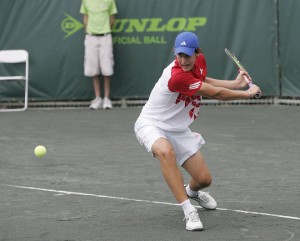Marina Erakovic was in complete control of her third-round match at Wimbledon, leading 6-1, 5-3 against British women’s hope Laura Robson. Pam Shriver, on ESPN2, commented that the New Zealander had had hit 22 winners against only two unforced errors to that point in the match. Then, all of the sudden, double-faults and errors crept into the Kiwi’s game and Robson won seven straight games en route to 1-6, 5-7, 6-3 victory.
Erakovic’s sudden reversal of fortune can be classified as a choke. We don’t want to single out Erakovic for getting tight and not being able to close out the match. You could say that some form of a choke happens in every match that is played at the All England Club. What is a choke and how can you prevent yourself for doing it? It’s a complicated subject, but world renowned Carlos Goffi offers a wide discussion on the subject in his newly republished and updated ebook TOURNAMENT TOUGH! A GUIDE TO PLAYING CHAMPIONSHIP TENNIS (available at www.HelpEBooks.com.) Goffi, the former coach of John and Patrick McEnroe, discusses choking in this exclusive book excerpt below. TOURNAMENT TOUGH, first published worldwide in 1984 and translated into many languages, includes valuable commentaries from John McEnroe, Patrick McEnroe, Peter Fleming and Mary Carillo. The book deals with all phases of technique and shot-making, but more importantly covers subjects as how to pace a match, choking, anticipation, fitness and, above all, mental toughness.
CHOKING
There are three feelings shared by all athletes, in every sport, at every level, and at every age: the exhilaration of winning, the disappointment of losing, and the agony of choking. Everything I have written so far shows you how to win more, but no matter how successful you become, there will always be times when you begin to choke or tighten up because of nervous tension. In the juniors it can happen often, so you have to know what to do and how to cope with it.
Choking is a perfectly normal reaction to pressure during which a metabolic change occurs, affecting your reflex and reaction time. Your heart starts beating faster, your breathing gets shallower, your muscles tighten, and your legs feel like lead.
On the tennis court this stiffness and sluggishness almost always occur on the big points, on the red points, and your ability to overcome this problem will be a deciding factor in your progress as a tournament competitor. Anybody can confidently play the point at 40-0 and 2-0, but fewer can do so at 30- all and 3-all.
Although the tennis player may experience choking as a physical sensation, the roots of the reaction can be traced to the mental pressures that build up during a match. The key to overcoming it is to maintain a positive mental attitude. Never start fooling yourself by blaming your “rotten” strokes, whether it’s your “uncontrollable backhand” or your “pathetic second serve.”
“Of course I get nervous, my backhand is so bad, I always make mistakes just when it matters most”; or by simply giving up and pretending it doesn’t matter anymore. You have to learn to TOUGH IT OUT! Champions are always prepared to let the match go the distance; they don’t panic if they can’t get a quick win.
I can’t stress too much how important it is always to keep your attitude positive on the court. Be one of those irritating players who are never put out by bad luck or an off day. Moaning how badly you’ve been playing has a curious way of becoming a self-fulfilling prophecy. Conversely, if you shrug off the ”bad-luck” shots and concentrate on the positive that, too, often becomes self-fulfilling.
When McEnroe and Connors started feeling this mental tightening and their strokes begin to knot up in their primes, their reaction was suddenly to get very aggressive. This seemingly contradictory behavior serves two purposes. First, it loosened them up, stopped the choking from becoming serious. Instead of starting to poke at the ball and pray for their opponents to make mistakes, they used forcing shots, cloaking their nerves with a strong and aggressive mental attitude. Second, by becoming unexpectedly aggressive at a time when their opponents knew the mental balance is very much against them or, is delicately poised, they often surprised these opponents into making mistakes or playing a defensive return, which they took advantage of. Watch the top players of today under pressure during a match. Watch how they pump themselves up, strutting across the court, wiggling their rackets from side to side – “lt may be a red point, and you may think I’m tight, but it is a red point for you too and you are also tight.”
Because these are great champions, they can actually push the odds and the mental balance back in their favor by this sort of pumping up, in effect changing the lights from red back to yellow. However, most of you aren’t a McEnroe or a Connors, at least not yet, so what should you do when you can feel yourself beginning to choke?
First, let’s identify when we do choke: when the score is even or when we are leading by a “comfortable” margin. We don’t choke when we are losing by a big margin. When the score is even, champions know that “the opponent is choking too” and, therefore, realize that they just need to “choke a bit less” than the opponent to get ahead. This realization in itself is good enough to make the tournament tough player more comfortable in these situations. However, the most difficult choking situation to handle is when you are up by a good margin, say 4-1 or 5-2 (most misleading scores in tennis), and you can taste the finishing line. The opponent has nothing to lose, he starts hitting out, his shots go in and he begins to pump himself up. In these situations, champions remain cool and collected by realizing that even if the losing player gets even, say at 4-all or 5-all, he will then begin to choke by thinking he can now win the set and that’s when the champion takes advantage of his opponent by choking a bit less and finishing him off. This situation happened in the match Patrick played Becker at Key Biscayne in 1991. Patrick won the first set 6-1 and led 4-2 in the second set. Although the crowd was amazed that Patrick was about to knock off a top seed, Patrick knew that a champion like Becker doesn’t just roll over and die. He was ready for a Becker comeback. After playing two great games to even the match, Patrick knew that Becker was now a little tighter than he was back at 2-4. Patrick choked a bit less than Boris at 4-all, broke his serve and closed the match at 6-4.
Don’t ignore the lights altogether and blast the ball, but do think more aggressively than defensively. As you become involved in the point, the tightness will gradually melt away; more importantly, you will have begun to dominate the mental dialogue with your opponent. When the match is even, he’s nervous, and he knows you should be nervous. By showing courage when he’s expecting you to push the ball, you can really swing the mental balance away from him.
There are a series of well-tried methods that you can use to overcome the physical symptoms of choking:
*During your pre-match routine, relax while you focus your attention, whether it is on having a rubdown, stretching, listening to music, or whatever. Sticking to the same routine before each match will also provide you with something familiar and therefore reassuring in an environment that can sometimes seem incredibly hostile.
*Realize that your opponent is experiencing the same pressure and stiffness, no matter how cool he looks. Even Borg admitted that he would get really nervous on big points, yet by acting cool, he allowed a myth to be built up around him, including the fact that his pulse rate dropped even lower as the pressure mounted. This just wasn’t so. He was no more immune to tension than any other mortal. He was simply psyched more sharply to handle it.
*Take deep breaths while concentrating on relaxing your legs, shoulders and your grip.
*Keep your feet moving.
*Make an extra effort to keep your mind on the match, the ball, the weather conditions, your opponent’s reactions, et cetera. And don’t get bogged down in the “what ifs” of choking: What if I don’t hold my serve? What if I lose? What will my friends say? What will my parents say?
*Shift the pressure to your opponent by becoming more aggressive. Show him that you can tough him out!
All of these methods will help alleviate some of the symptoms of choking but will never eradicate them altogether. If you play competitive tennis, you will always be under some kind of pressure, and you must get used to that feeling and used to handling it. Having sat in the locker room with McEnroe before the finals of major tournaments, with tension seeping out of every crack in the walls, I know that anyone without a top pro’s experience of coping with pressure – big pressure – wouldn’t even have been able to walk down the tunnel to the stadium court.
Just as McEnroe learned to tough it out by hard-won experience, so you must learn to tough it out by exposing yourself to competitive pressure at every opportunity you have on the tennis court. Even if you are relatively inexperienced in tournament play, you can build up your resilience to pressure by making your practice sessions more competitive, and by becoming more competitive in all the other games you play.
When you are playing a game of basketball or chess, for that matter, go all out to win, put yourself on the line, and get tournament tough.






